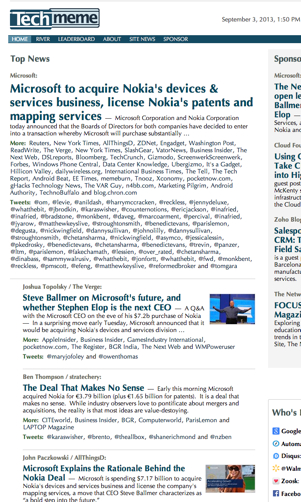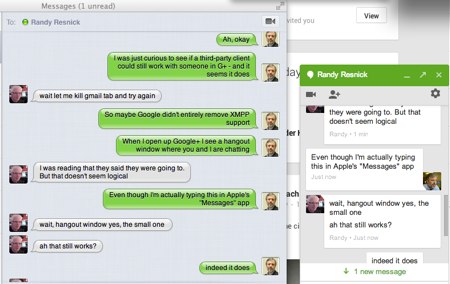 What makes the Opus codec so interesting? Why is there such a buzz about Opus right now? If you are not in telecom or doing anything with audio, why should you even remotely care about Opus?
What makes the Opus codec so interesting? Why is there such a buzz about Opus right now? If you are not in telecom or doing anything with audio, why should you even remotely care about Opus?
In a word…
Innovation!
And because Opus has the potential to let us communicate with each other across the Internet with a richer and more natural sound. You will be able to hear people or music or presenters with much more clarity and more like you are right there with them.
Opus can help build a better user experience across the Internet.
You see, the reality is that today “real-time communication” using voice and video is increasingly being based on top of the Internet Protocol (IP), whether that communication is happening across the actual Internet or whether it is happening within private networks. If you’ve used Skype, Google+ Hangouts, any voice-over-IP (VoIP) softphones, any of the new WebRTC apps or any of the mobile smartphone apps that do voice or video, you’ve already been using IP-based real-time communication.
Dropping The Shackles Of The Legacy PSTN
Part of the beauty of the move to IP is that we no longer have to worry about the constraints imposed upon telecom by the legacy Public Switched Telephone Network (PSTN). Chief among those constraints is the requirement to use only part of the sound frequencies we can hear. You all know the “sound” of the telephone – and you hear it in any movie or TV show when someone is using the phone. It’s that certain “sound” that we are all used to… that’s what the “phone” sounds like.
In technical terms, we call this “narrowband” audio and it has a frequency range of only 300-3400 Hz.
There are historical reasons for this limitation in telecom, but moving to IP-based communications removes those limits. With VoIP we can use what is called “wideband” audio to have a full rich sound to our voice or video call.
Have you had a really good Skype connection with someone where it sounded like they were almost right there in the room with you?
That is wideband audio.
The Codec Problem
Now, for voice or video over IP to work, you need to use something called a “codec” to translate the sound of your voice to digital bits and carry them across the network (and to do the opposite for whomever you are speaking with). There are MANY audio codecs out there and they come in all sorts of flavors and with all different kinds of capabilities. The problem has been that there hasn’t been a codec that:
- is optimized for interactive Internet applications;
- is published by a recognized standards organization; and
- can be widely implemented and easily distributed at little or no cost.
In particular that last point about the cost of licensing, especially for wideband codecs, often caused developers to shy away from giving us the rich voice quality that we can now have with IP. Or, in the case of companies like Skype or Google, they went out and bought companies who created wideband codecs so that they could use those codecs in their products. (See my story from 2010 about Google buying GIPS.)
Now there are free codecs out there that developers can use. For narrowband, there has been the ubiquitous G.711 which provides an IP version of “PSTN audio”. There have been many others, including notably Speex.
But the struggle has been that there hasn’t been a widely accepted “G.711 for wideband” equivalent that developers can just bake into their products and start using. Instead there have been a number of different, incompatible codecs used in different products.
Enter Opus…
So to address these points, back in 2010, engineers within the IETF got together and formed the CODEC Working Group to come up with a codec that could meet these requirements and become the ubiquitous wideband codec used across the Internet. Skype was involved early on through contributing their SILK codec. The folks at Xiph.org contributed their CELT codec. People from many other companies got involved and there were huge technical discussions on the mailing lists and at IETF meetings.
And it worked… the Opus codec was standardized in RFC 6716 in September 2012.
You can read all about the codec at:
http://www.opus-codec.org/
The key points are at the beginning:
Opus is a totally open, royalty-free, highly versatile audio codec. Opus is unmatched for interactive speech and music transmission over the Internet, but is also intended for storage and streaming applications.
Open, highly-versatile… and royalty-free.
At that site there is some great information, including:
There is also a FAQ and many other great pieces of information.
So Why Does Opus Matter?
Opus matters because it lets developers focus on creating a high quality user experience and not having to worry about codec incompatibilities and licensing issues.
Opus matters because it lets developers easily create applications with high quality audio. They can just start using available libraries and communicating with other applications and devices using a common wideband codec.
Opus matters because it can work in very low-bandwidth environments enabling real-time communications across Internet connections that might not previously have supported such communications. As we start to get more Internet connectivity out to the 5 billion people not yet on the Internet, the ability to work over different kinds of connections is critical.
Opus matters because it can help foster innovation in applications and the user experience. Opus is the default audio codec for WebRTC, and so all the zillion new WebRTC-based apps and startups are already beginning with a far superior audio experience than we’ve had before.
Opus matters because it will enable even more ways that we can connect with family members or friends and have the experience of being “right there”. It can help musicians collaborate better across the Internet. It can help podcasters and journalists deliver higher quality interviews across the Internet. It can, in the best conditions, give us that rich audio experience we get when we are right with someone – even though we may be thousands of miles away.
Opus can help us deliver on the potential of the Internet to create more powerful user experiences and to help us better communicate.
THAT is why Opus matters.
Learn More At Monday’s IETF 87 Technical Plenary
To understand more about the current status of Opus, who is using it and where it is going, the IETF 87 Technical Plenary on this coming Monday evening in Berlin, Germany, will have a special segment focused on Opus that will include a number of people involved with the Opus work. The agenda for the session can be found at:
http://trac.tools.ietf.org/group/iab/trac/wiki/IETF-87
It is happening from 17:40-19:40 Berlin time, which is Central European Summer Time, which is currently UTC+2 and 6 hours ahead of where I live in US Eastern time. If you can’t be there in person, there are several remote options:
If you are unable to watch the meeting in real time it will be archived for later viewing.
The first option above to listen to the session using the Opus codec (and WebRTC!) is a very cool one. The panel also includes people who have actually implemented Opus including people from Google and also Emil Ivov from the Jitsi softphone. Their insight into what they did will be great to hear.
What’s Next?
So if Opus is so great, how do you get it?
Well, if you are using any of the WebRTC apps popping up all across the Internet, you are already using Opus. As I noted above, the Jitsi softphone supports Opus. In an interesting bit of synchronicity, I noticed that Michael Graves wrote today about the Blink softphone now supporting Opus. More and more communications apps are starting to implement Opus.
If you are a developer of communications apps or services (or a product manager), you can look at how to incorporate Opus into your application or service. There is documentation and software available to help with the process, and many people are out there who can help.
If you are a user of IP-based communications apps or services, ask the company or vendor behind those services when they will support Opus. See if you can get it on their radar as something to implement.
And regardless of what you do with audio, let people know that this new way of communicating exists – help spread the word about Opus – let people know that audio across the Internet can be even better than it has been to date.
As you can tell, I’m excited about the potential – and very much looking forward to seeing what happens as Opus gets more widely deployed.
What do you think? If you are a telecom developer, or a vendor of such services, have you implemented Opus already? Are you thinking about it? (and if not, why not?)
An audio commentary on this post is available at:
If you found this post interesting or useful, please consider either:
 Microsoft accomplished something today they haven’t done for a while (at least in my memory) – they dominated the main page of Techmeme and had a great amount of the tech media talking about them.
Microsoft accomplished something today they haven’t done for a while (at least in my memory) – they dominated the main page of Techmeme and had a great amount of the tech media talking about them.
 Can we create a “secure Caller ID” for IP-based communications, a.k.a. voice-over-IP (VoIP)? And specifically for VoIP based on the Session Initiation Protocol (SIP)? Can we create a way to securely identify the origin of a call that can be used to combat robocalling, phishing and telephony denial-of-service (TDOS) attacks?
Can we create a “secure Caller ID” for IP-based communications, a.k.a. voice-over-IP (VoIP)? And specifically for VoIP based on the Session Initiation Protocol (SIP)? Can we create a way to securely identify the origin of a call that can be used to combat robocalling, phishing and telephony denial-of-service (TDOS) attacks? Want to learn more about the Opus codec and why it is so important? As I mentioned at the end of
Want to learn more about the Opus codec and why it is so important? As I mentioned at the end of  Seeking to understand the basics of
Seeking to understand the basics of  Do “smart” parking meters really need phone numbers? Does every “smart meter” installed by electric utilities need a telephone number? Does every new car with a built-in navigation system need a phone number? Does every Amazon Kindle (and similar e-readers) really need its own phone number?
Do “smart” parking meters really need phone numbers? Does every “smart meter” installed by electric utilities need a telephone number? Does every new car with a built-in navigation system need a phone number? Does every Amazon Kindle (and similar e-readers) really need its own phone number?
 My post this week
My post this week 